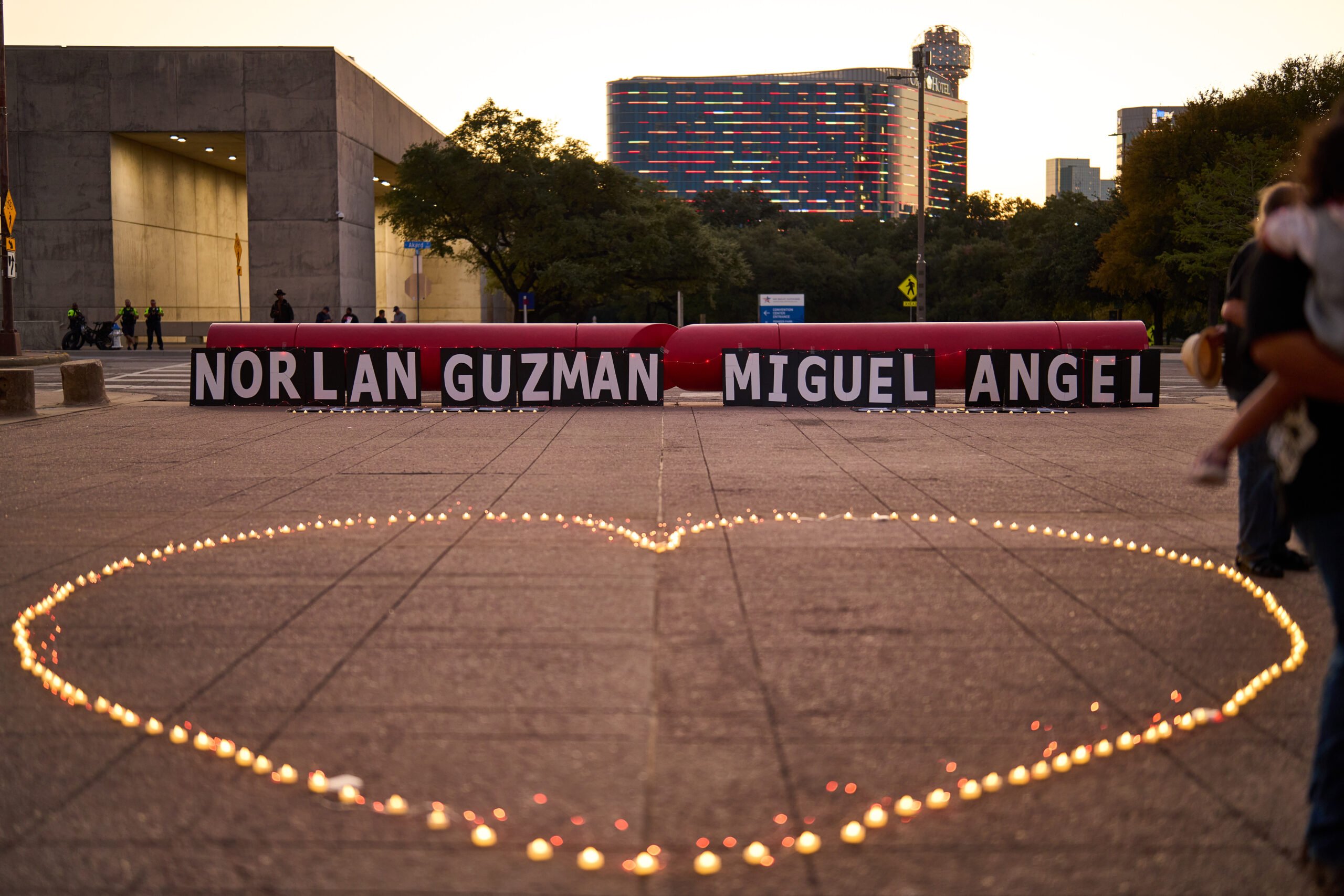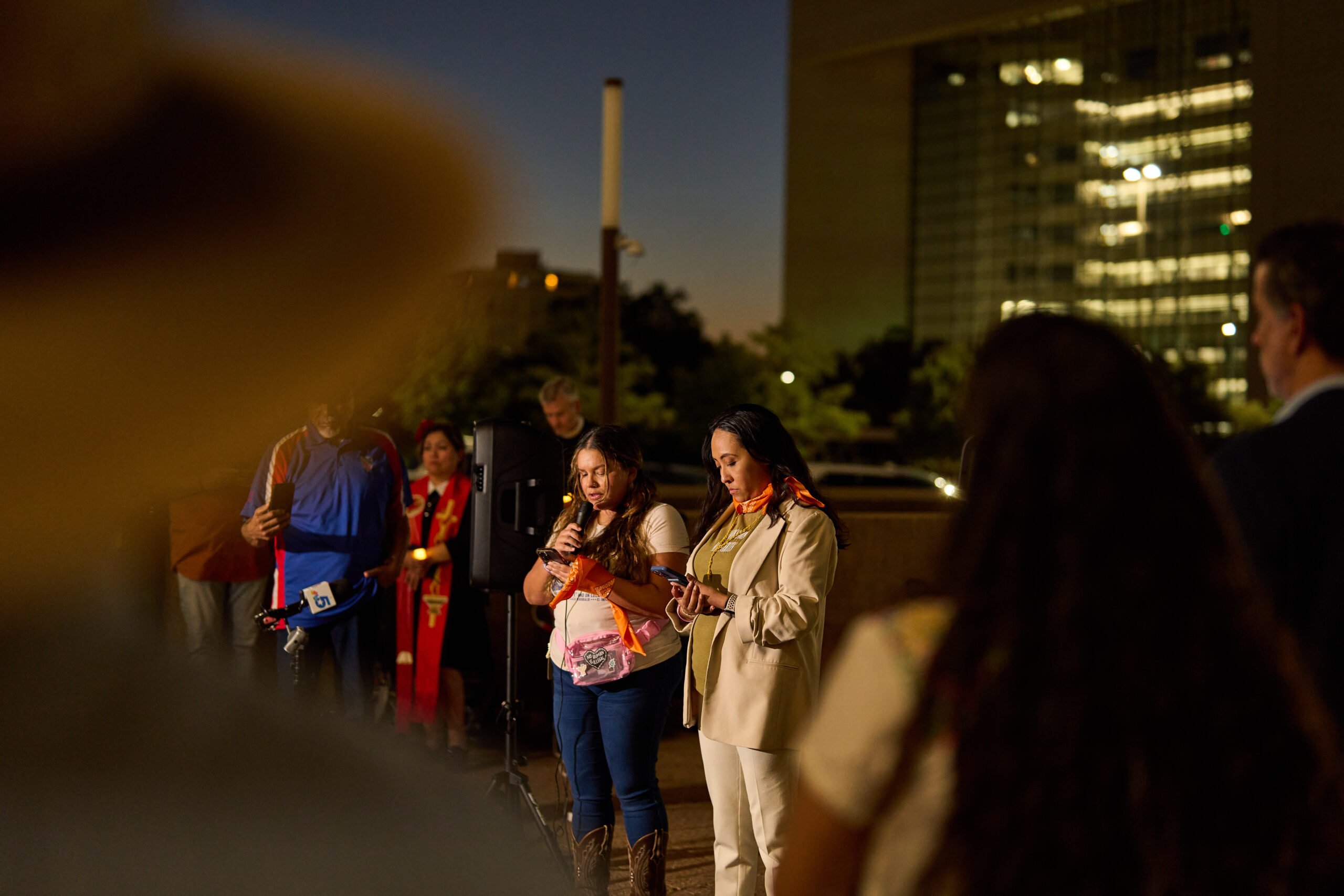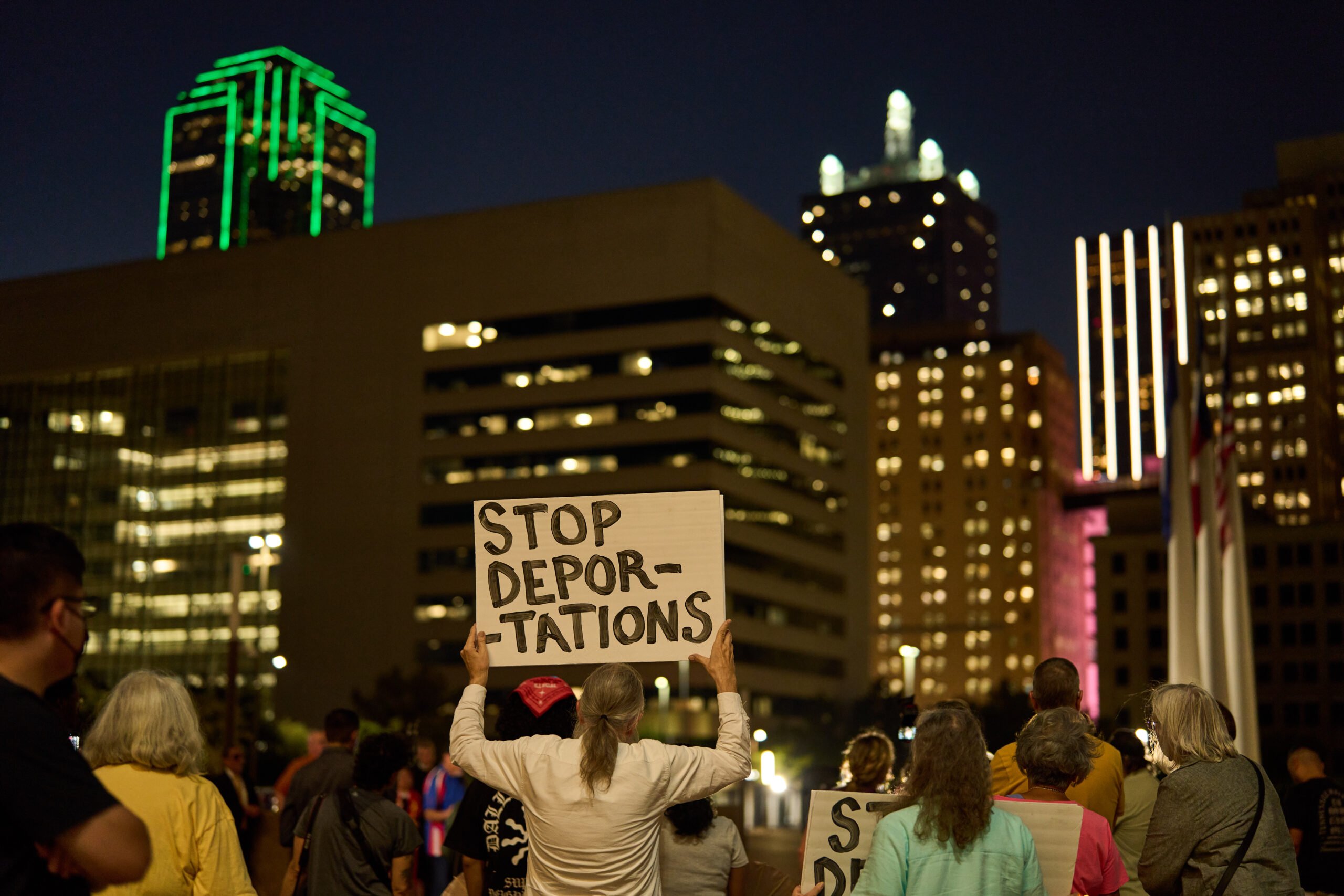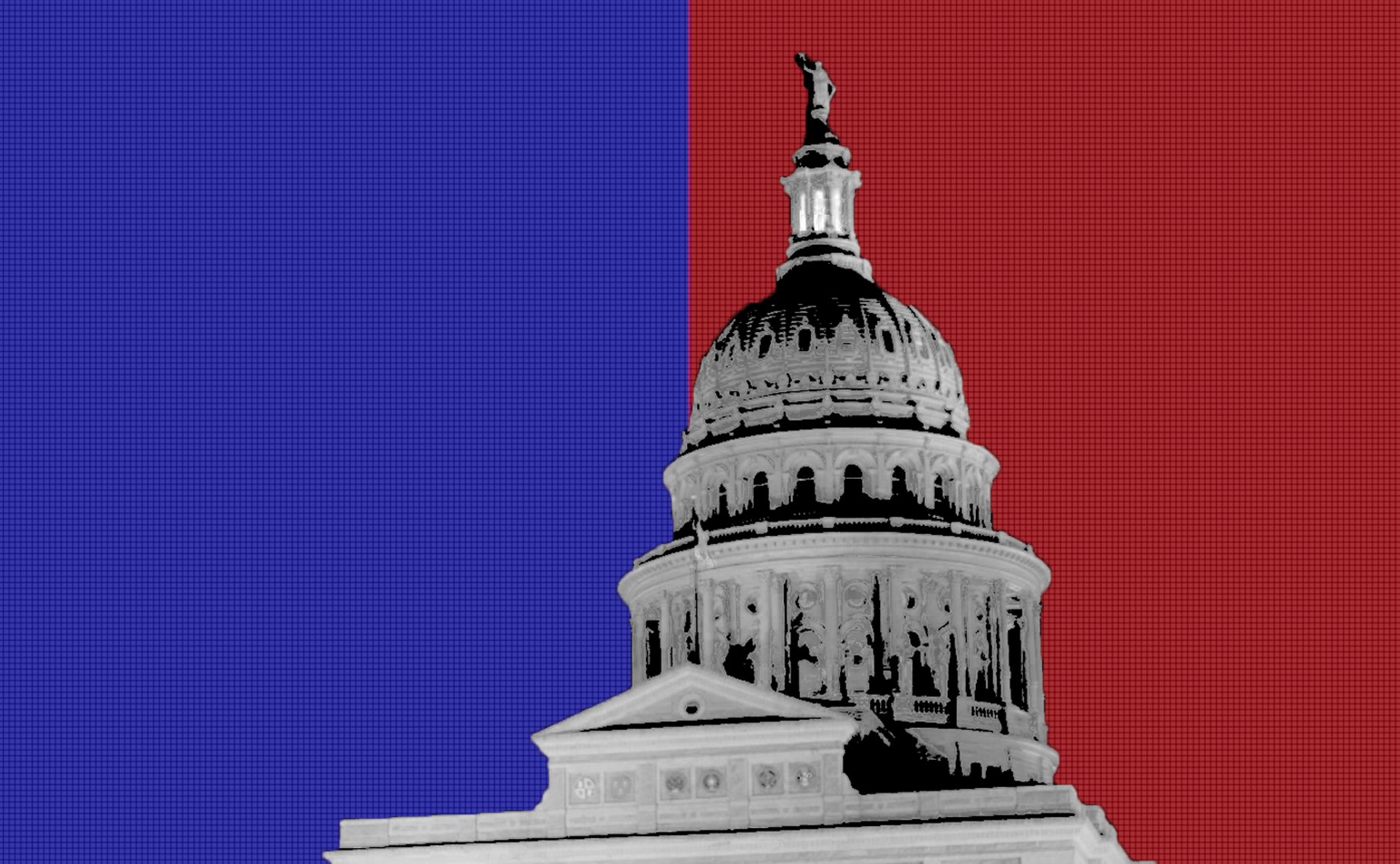
In Dallas, Organizers Mourn the Immigrant Victims of Recent ICE Shooting
At a vigil outside city hall last week, advocates gathered to “center the victims” and to condemn the “dehumanization” of migrants by the federal government.
On September 24, a gunman shot at the Immigration and Customs Enforcement (ICE) field office in Dallas, killing two immigrants, Norlan Guzman-Fuentes and Miguel Ángel García-Hernández, and seriously injuring another, Jose Andres Bordones-Molina, who were being detained at the site.
The federal government was quick to blame the attack on the “far left” and the “dehumanization” of ICE agents “who are simply enforcing the law.” Around four hours after the shooting, FBI Director Kash Patel posted a photo of bullets with the message “anti-ICE” written on them allegedly found at the scene, citing this as evidence of the suspected shooter’s “idealogical [sic] motive.”
But for the immigrant community in Dallas, the shooting is yet another instance of the violence and fear they have endured under President Donald Trump’s nearly $30 billion “deportation-industrial complex” and a continuation of the lack of transparency and accountability from the local and federal governments alike.
The immediate aftermath of the shooting was marked by panic and fear in the immigrant community. At a vigil two days after the shooting, at Parkland Hospital where victims were being treated, Noemi Rios, an organizer with the Chicana-led community initiative Vecinos Unidos DFW, said that local organizations were being flooded with requests seeking more information about the identity of the victims. Rios told reporters that family members who “knew their loved ones had been detained” at the Dallas ICE field office “couldn’t get confirmation of life or death.”
Flaka Martinez, another organizer with Vecinos Unidos, said that this panic was the result of ICE’s detainee locator system, which has been criticized by families of detainees and their lawyers for not providing up-to-date information regarding the whereabouts of detainees. Martinez urged that anyone detained by ICE must have their unique identification numbers (known as an “A-Number”) put into the system within 12 hours of detention. She also pointed to the fact that the facility where the shooting happened was not a detention center but rather an administrative office where people frequently visit for check-ins with ICE. “It’s not sustainable, nor safe to detain people at that facility,” Martinez said.

Well before the shooting, family members with loved ones detained at that Dallas field office reported inhumane conditions in the facility, including overcrowding, medical neglect, and individuals being detained for more than a week without access to running water and air conditioning. Over 600 people were held at the field office in June and July for longer than ICE’s own 12-hour limit on detention in so-called “hold rooms,” according to data obtained by the Deportation Data Project and analyzed by El Movimiento DFW, a local group advocating for immigrant rights. Protests and public pressure led in part by Vecinos Unidos and El Movimiento led Democratic Congressmembers Julie Johnson, Marc Veasey, and Jasmine Crockett—who all represent parts of Dallas—to send a letter to Department of Homeland Security (DHS) Secretary Kristi Noem and Todd Lyons, acting director of ICE, on July 28 demanding “immediate answers” to reports about the field office. As of October 6, the U.S. representatives have not received a response.
For the immigrant community in Dallas, this lack of transparency around what advocates claim are unlawful and unjust detentions has become an expected response not just from federal law enforcement but local police as well. While the Dallas Police Department (DPD) maintains no official 287(g) agreement with ICE, it has stated that the department “regularly” interacts with federal agencies and will “assist these agencies upon request.”
Tony Rodriguez, the regional commander of the Brown Berets of North Texas, a community defense group that runs an “ICE Watch” in the area, said that the DPD’s public comments are “political double speak.” Rodriguez pointed to a recent multi-agency operation led by Homeland Security Investigations, an arm of ICE, on the Chicas Bonitas Strip Club in Dallas for suspected “human trafficking and unlawful employment.” Rodriguez said that as soon as the Brown Berets’ ICE Watch was alerted of a possible raid, members of the organization were on the scene, collecting testimonials and documenting the arrests.
Corbin Rubinson, spokesperson for DPD, wrote in an email to the Observer that the department was “requested to provide perimeter security during the outside agency’s operation.” According to an ICE press release, federal agents arrested 41 undocumented immigrants; just five had criminal records in the United States.
With suspicion from community organizations already high, Senate Bill 8 could dramatically change how immigration enforcement is conducted in the state. SB 8 will force county sheriffs to enter into 287(g) agreements with ICE by next December, which could give deputies the authority to arrest and detain people off the street on the basis of immigration status depending on the 287(g) model a sheriff selects. As the Texas Observer has previously reported, around 30 local county sheriffs and police departments have already voluntarily inked “task force model” agreements, which effectively deputize local officers as ICE agents.

The ever-expanding relationship between local law enforcement and federal immigration authorities is a key detail in how one of the victims of the September 24 shooting, Guzman-Fuentes, a 37-year-old from El Salvador, ended up at the Dallas ICE Field Office that day. According to a press release from ICE, DPD arrested Guzman-Fuentes on August 25 on an aggravated assault charge—which ICE said was later dropped—and an outstanding warrant for a DUI. Shortly after Guzman-Fuentes was booked at the Dallas County Jail, ICE “encountered him” and filed an immigration detainer. The press release states that he was being transferred into the office that morning when the shooter opened fire, killing him and García-Hernández, a 32-year-old immigrant from Mexico who passed away due to his injuries five days later.
As previously reported by the San Antonio Express-News, ICE is increasingly using county jails to detain undocumented immigrants before they are taken into federal custody and ultimately deported. While all Texas county jails have been sharing biometric data with ICE since 2010, since January of this year, the number of immigration detainers filed on immigrants booked at the Dallas County Jail has increased by 71 percent. When SB 8 goes into effect, those rates could further increase.
At a vigil held at Dallas City Hall on October 3, organizers gathered to “center the victims of the shooting” and to condemn the “dehumanization” of migrants by the Trump administration.
Kate Lincoln-Goldfinch, an Austin immigration attorney and legal advisor to the League of United Latin American Citizens who has been in contact with the families of the victims, told the Observer that for families, the loss of their loved ones has been compounded by the “way that the government has responded, by not giving them information quickly.” CBS reported that Guzman-Fuentes’ wife only found out that her husband had been killed after contacting the Salvadoran consulate. Organizers also read a statement from his sister, who said she wants people to remember her brother as “the greatest brother, tío, and friend.” The statement also noted that officials told her that she wouldn’t be able to see her brother’s body and would only be offered two hours for a funeral.
Eric Cedillo, an attorney representing García-Hernández’s wife, told the crowd that he must be remembered for his “heroism.” Cedillo said that when “bullets crashed through the window and hit Miguel,” he turned to the 18 year-old boy sitting next to him in the van and said, “I don’t think I’m going to make it, get underneath me. Let me shield you.”
Looking ahead, Martinez, the community organizer, said that in spite of the Trump administration using the shooting as a pretext to vilify resistance to ICE, her community is determined to continue to fight against Trump’s deportation machine and “serve justice for [the victims’] families.”



